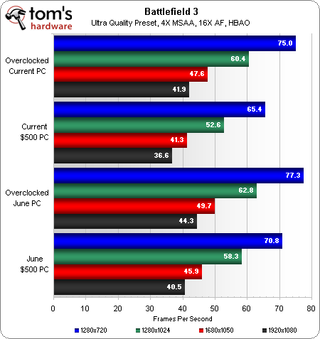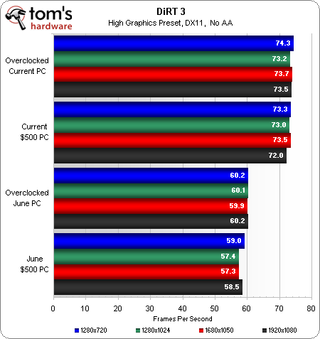System Builder Marathon, August 2012: $500 Gaming PC
Benchmark Results: Battlefield 3 And DiRT 3

Battlefield 3
Up next is Battlefield 3’s single-player campaign, the most graphically demanding test in our current gaming suite. There are more stressing areas encountered within the game than our 90-second Fraps run, so I shoot for an average of 45 frames per second as a minimum target.
Vindication! This quarter's efforts successfully reduce the CPU limitation seen at the lowest resolution. Eventually, when it comes to pushing a higher number of pixels, both rigs demonstrate similar capabilities, pretty much breezing though these medium quality settings.

With the bulk of funding poured into graphics, last quarter's rig was designed specifically to attack our most punishing gaming test, Battlefields 3’s Ultra quality preset. Our gamble paid off, as the overclocked GeForce GTX 560 Ti provided enough 3D muscle to at least consider the single-player campaign playable (albeit just barely at 1920x1080). Equally important, our potent little Celeron G530 did not disappoint.

Although this new machine is more balanced overall, shifting $40 from the graphics budget to our CPU does incur a performance hit under Battlefield 3's Ultra quality preset. Today's build trails by a small margin at all resolutions. Although a 2 to 4 FPS loss in both average and minimum frame rates might seem insignificant, actually playing through the game at those settings confirmed we were pushing this rig's limitations.
We’ve come at this from so many angles now that we can dial in hardware recommendations for these settings. In the single-player campaign, processor performance isn't heavily taxed. Any dual-core Sandy Bridge-based chips seems up to the task. As far as graphics go, a GeForce GTX 560 Ti, Radeon HD 6950, or an overclocked GeForce GTX 560 are good minimum targets for 1680x1050. At 1920x1080, we suggest at least an overclocked GeForce GTX 560 Ti.
DiRT 3
Stay on the Cutting Edge
Join the experts who read Tom's Hardware for the inside track on enthusiast PC tech news — and have for over 25 years. We'll send breaking news and in-depth reviews of CPUs, GPUs, AI, maker hardware and more straight to your inbox.
Little scaling is witnessed on either system at DiRT 3’s High graphics preset. The GeForce cards are held back by their respective dual-core CPU pairings.
Note that the new machine's 26% increase in both average and minimum framerates isn’t too beneficial, but it demonstrates the processor’s influence in this title and will boost this quarter's score when it comes time for the overall gaming performance evaluation.


The demands of Ultra details with 8x AA applied start to expose graphical limitations.
The current rig leads at lower resolutions in both average and minimum frame rates, but the two systems eventually even out at 1920x1080. Once we consider graphics overclocking, today's build pulls a 2 FPS lead in average and minimum frame rates, suggesting that June’s Celeron processor remains a bottleneck to some degree.
Current page: Benchmark Results: Battlefield 3 And DiRT 3
Prev Page Benchmark Results: Synthetics Next Page Benchmark Results: The Elder Scrolls V: Skyrim And StarCraft II-
crisan_tiberiu so, looks like 500$ (Euro in europe :P) its enaugh to play any modern game that is trown on the market... ty consoles :PReply -
itzsnypah I think it would be interesting if next quarter for your Budget PC you try to bring the performance per watt as high as you can while still maintaining an enjoyable gaming experience. Something like a G620+HD7750/70 with a high efficiency PSU such as Rosewill CAPSTONE 450.Reply
Ever since I read the 7950B/7970GE review on here/anand performance per watt for me has been a priority when selecting components. -
mayankleoboy1 ReplyI think it would be interesting if next quarter for your Budget PC you try to bring the performance per watt as high as you can while still maintaining an enjoyable gaming experience. Something like a G620+HD7750/70 with a high efficiency PSU such as Rosewill CAPSTONE 450.
On the contrary, for a 500$ build, energy consumption and heat should be least concerns. Tweaking, overclocking and extracting the last possible performance from your hardware are the primary concerns of a 500$ gaming build. Even after HEAVY overclocking, you wont get 50W over the stock settings. -
sam_fisher mayankleoboy1On the contrary, for a 500$ build, energy consumption and heat should be least concerns. Tweaking, overclocking and extracting the last possible performance from your hardware are the primary concerns of a 500$ gaming build. Even after HEAVY overclocking, you wont get 50W over the stock settings.Reply
One may presume that someone after a $500 build is on a budget and hence doesn't want higher power consumption from overclocking.
-
yyk71200 Well, considering that I already have 3570K with GTX570, I'll be interested only in either $2000 PC or a graphic card from a $1000 PC.Reply -
itzsnypah mayankleoboy1On the contrary, for a 500$ build, energy consumption and heat should be least concerns. Tweaking, overclocking and extracting the last possible performance from your hardware are the primary concerns of a 500$ gaming build. Even after HEAVY overclocking, you wont get 50W over the stock settings.According to the performance summary and efficiency page of this article Overclocking the GPU had a 13%(average according to this article) increase in power consumption for an extra 2% (average) performance. That seems like the opposite thing I'm talking about.Reply
Overclocking is good for performance per dollar, not performance per watt. -
abegnale @Paul Henningsen,Reply
Why not substitute some existing parts for either an I3-2100 and/or an eVGA 560 Superclocked? -
giovanni86 Nice, looking forward to the next builds. Some times OC does yield its advantages, those few frames can help and have helped me in games running smoothly or just over 30FPS. I honestly don't see why people are concerned with power, PC's don't cost much to run even overclocked. Unless your poor or working at McDonald's, then i see no reason why power is an issue unless otherwise stated. This whole green thing is a pain in the ass. I'm power hungry sorry.Reply
Most Popular

